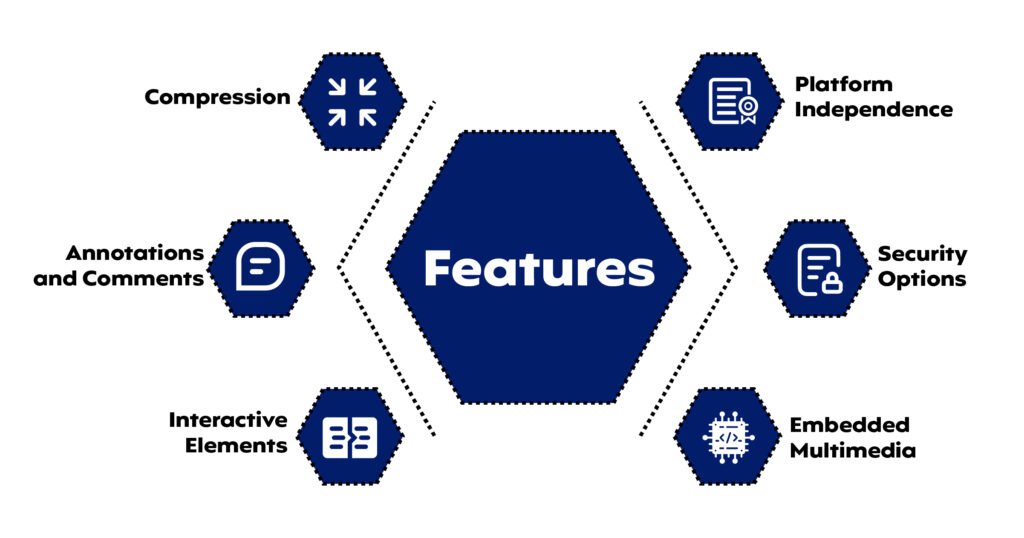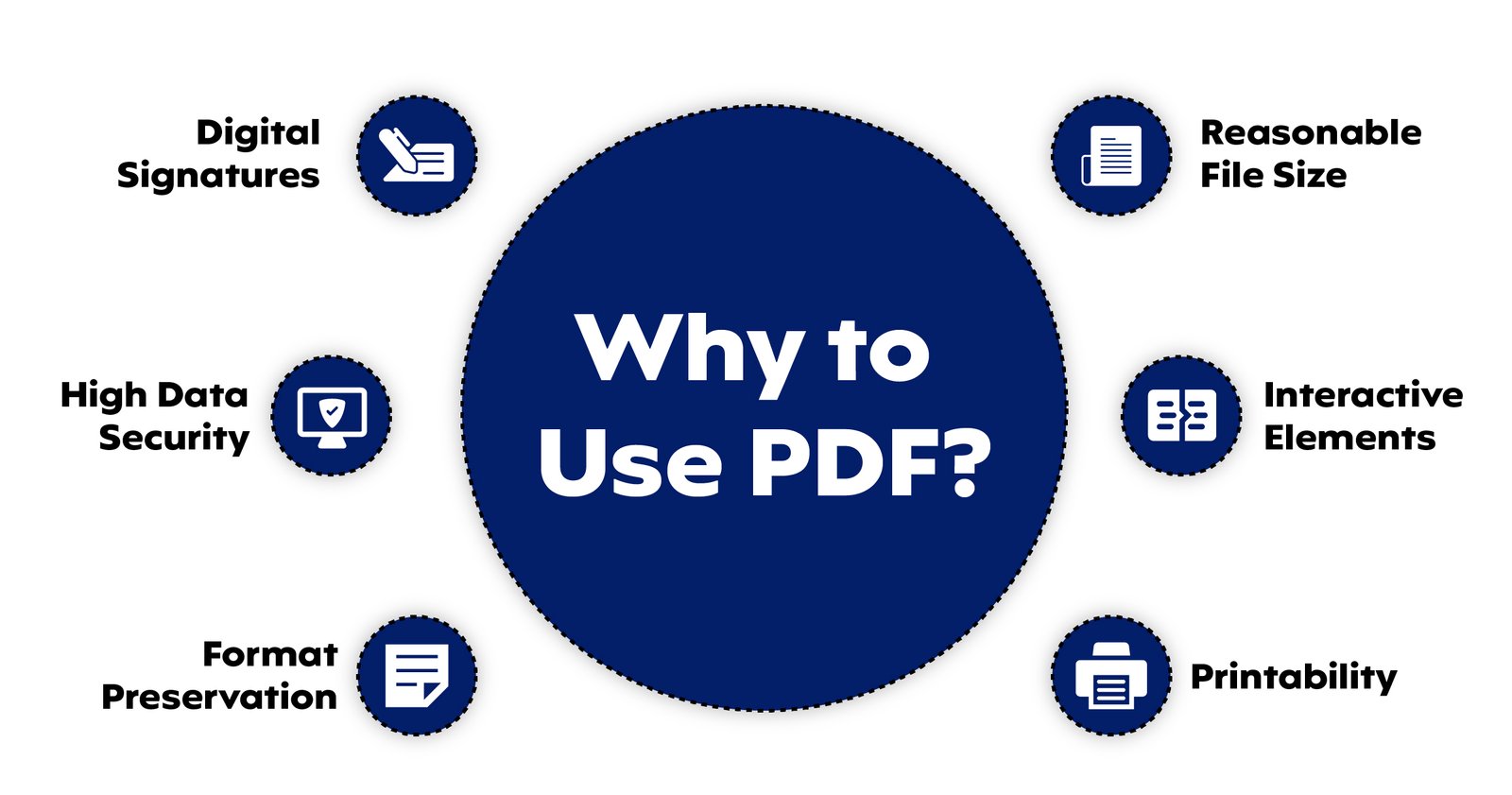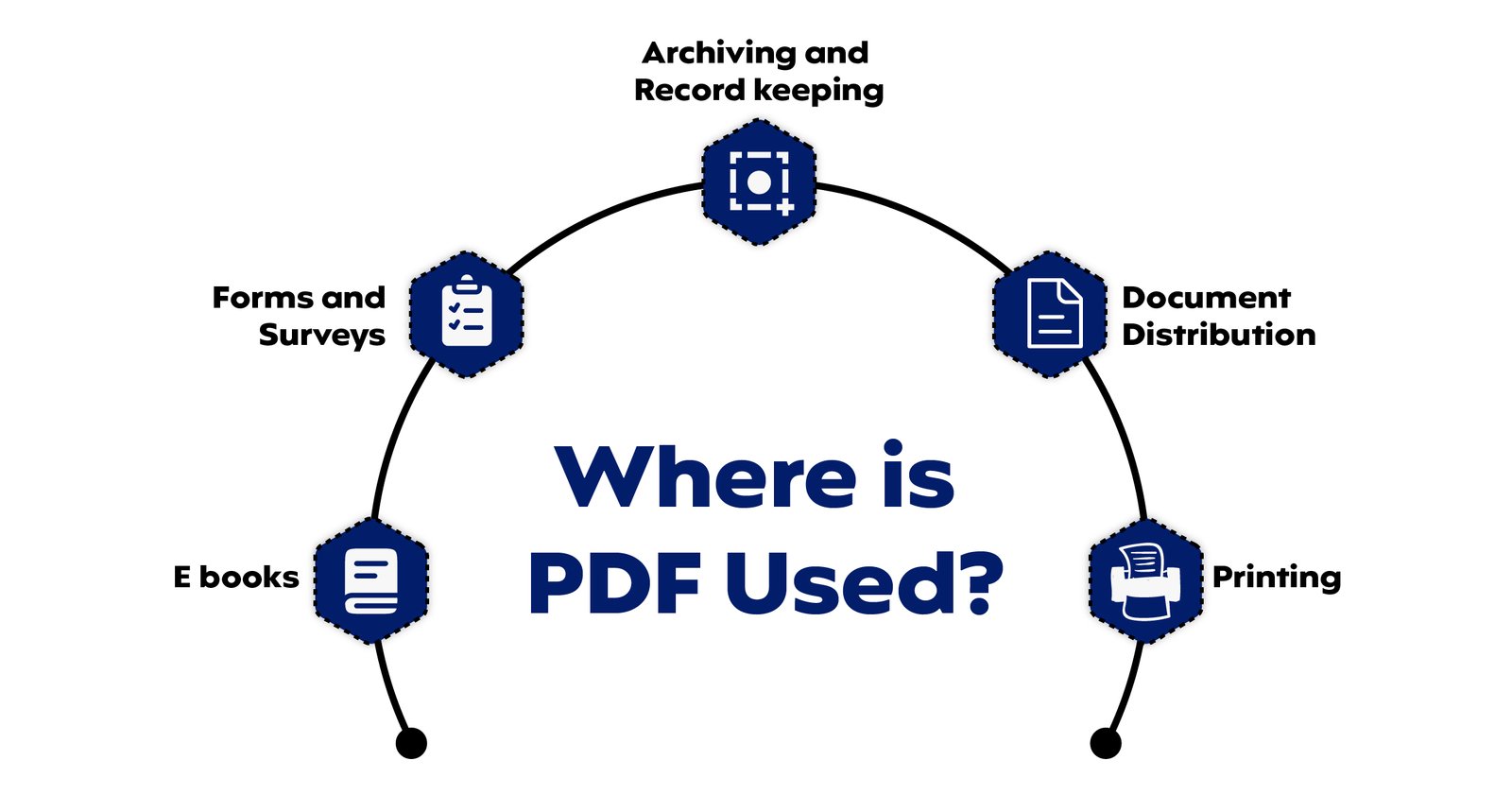PDF (Portable Document Format) is a file format that simplifies information sharing. It was designed so that any user, regardless of device or software, could open and read the file from any location. PDFs always look precisely as the developer intended since they maintain the same layout, text, and images.
You created a fantastic paper with vibrant fonts and images, but the colours or text change when you transmit it to a buddy. This won’t occur with a PDF! Because the file remains “locked” in place, anybody who opens it will see exactly what you made—no changes.

Table of Contents
ToggleAn Overview of PDF History
Adobe first created PDFs in the early 1990s. Sharing documents between computers was challenging back then. When someone made a document on one computer and submitted it to another, the file frequently looked utterly different. Images may disappear, fonts may alter, and the arrangement might become messy. Sharing essential documents like contracts, reports, and presentations made it challenging and annoying.
After noticing this issue, Adobe created the PDF to solve it. Their goal was to create a file anyone could open and read, regardless of location or device. 1993 When Adobe released the PDF format, it immediately gained popularity in government, business, and educational institutions. PDFs preserved the layout, colours, text, and images exactly as they were stored.
PDFs improved further with time. Adobe included new functionality, such as adding links, completing forms, and password-protecting documents. These days, PDFs are among the most widely used file formats worldwide. Thanks to PDFs, sharing documents is now quicker, simpler, and more reliable than ever!
What Makes PDFs Useful?
PDFs are incredibly popular because they make sharing and storing information so simple. We use PDFs for the following key reasons:
Consistency
No matter where you open a PDF, it always looks the same. This means that its content, images, and layout will all be the same whether viewed on a computer, tablet, or phone. This keeps everything organized, which is excellent for sharing content that needs to appear transparent or professional.
Security
A password can be used to secure PDFs. PDFs are useful when exchanging confidential information, such as a contract or a form including personal details. Your information remains safe from unauthorized access by password security.
Minimal File Size
PDFs are small files that can hold much information. They “compress” data using unique technology, which lowers the size of the file. Because of this, PDFs are quick to download and simple to distribute by email, even if they contain a lot of pages or photos.
Flexibility
Not all PDFs are for text. Some PDFs contain charts, images, videos, and hyperlinks. Thus, they are helpful for various publications, such as school projects, company reports, e-books, resumes, and instruction manuals.
PDFs are both extremely compatible and highly credible, making them an excellent choice for document sharing across virtually all devices. This credibility reassures many people, whether at home, work, or school!

How Do PDFs Work?
Text, fonts, graphics, and layout are all contained within a single file, which is how PDFs operate. Consider it to be a “snapshot” of the document itself. When someone opens the PDF, it seems precisely like the original because this snapshot fixes everything.
This is a basic breakdown of how PDFs work:
Fixed Layout
PDFs maintain their “fixed layout.” This indicates that the structure of the document is unchanged. The photos won’t change, the text won’t move, and the colors won’t blend. When sharing files, this is crucial since you can be sure that the recipient will view exactly what you produced.
Independent
The PDF is self-contained in every way. This implies that it has all the components required to seem the same, even on a device with different software or fonts. Because of this, opening a PDF on any computer or phone is simple.
Compression
PDFs use a unique method to minimize file size. Even if the document has many pages and images, the file size stays smaller. This speeds up transmission and makes it easier to store on your device.
Format Ready for Printing
PDFs are made to be “print ready.” This indicates they are set up to display nicely on screens and in print. Because they can be read online or printed off, if necessary, PDFs are frequently used for flyers, brochures, and instructions.
PDFs enable easy and reliable information sharing by integrating all the components in a way that maintains stability. Because of this technology, people worldwide can now confidently write, exchange, and print documents.
Kinds of PDF
Depending on their intended usage, PDFs can be classified into many categories. The following are a few of the most popular PDF formats:
Editable PDFs
You can input, add information, or even edit details directly in these PDFs. Forms that you must complete, such as surveys, school enrollment forms, and job applications, are frequently in the form of editable PDFs. You can open these PDFs without printing anything and type straight into the spaces provided.
Non-Editable PDFs
PDFs that cannot be edited are more like images or snapshots of a document. They preserve the original document properly, reassuring the audience about its authenticity. These PDFs are essential for documents that must remain the same, such as user manuals, certificates, or signed contracts. They help maintain the secrets of crucial records.
Scannable PDFs
A paper document is scanned into a digital format to create a scanned PDF. It’s like taking pictures of every page and converting it to a PDF. You cannot change these PDFs unless you use specialized software to “recognize” the text. Copies of historical documents, medical records, and receipts are frequently stored in scanned PDFs.
Interactive PDFs
Special PDFs with clickable sections are called interactive PDFs. They may have parts you can fill out, buttons, or website connections. E-books, presentations, and digital forms frequently use interactive PDFs. An interactive PDF may allow you to navigate to a different page inside the document or visit a website by clicking on a link.
Understanding the differences between the various PDF formats can help you select the best one for your requirements. A PDF is designed specifically for the task, whether completing a form, reading a handbook, or storing a scanned page!
Popular Uses for PDFs
PDFs are used for a wide variety of documents and are flexible. The following are some of the most popular uses for PDFs:
Applications for jobs and resumes
Sending your CV as a PDF when applying for a job guarantees that the formatting remains consistent. Your resume will appear to employers as you designed it, with no messy layout or font changes.
Instructional guides
Because PDFs are simple to download and view on any device, businesses utilize them for instruction manuals. PDFs are frequently used for “how-to” publications, appliance instructions, and product guides.
E-books
PDF e-books, with their ability to present many pages, photos, and text in an engaging format, are a popular choice among readers. They offer a visually appealing reading experience, whether on screen or in print.
Contracts and Legal Records
Because PDFs may be “locked” to prevent alteration, they are frequently used for legal documents and contracts. This guarantees that everyone sees the same version and helps preserve the original data.
Reports and School Assignments
Students and teachers share assignments, research papers, and presentations via PDFs. PDFs simplify Sending files because you don’t have to worry about how they will appear on different devices.
Brochures and Flyers
PDFs are versatile advertising tools, particularly for flyers and brochures. Their ability to maintain the original layout ensures they look great, whether viewed online or printed. This is why businesses often use PDF flyers to promote their deals, events, and services.
PDFs are used in various ways, from job applications. They are a widely used format that people rely on to keep papers neat, safe, and easy to share!

How to See and Edit PDF Files
It’s simple to open a PDF without the need for specialized software. Here’s a quick tutorial on opening and editing PDFs on various devices:
Open PDFs:
- On a computer: Most PCs include a PDF viewer. Double-clicking on the PDF usually opens in Adobe Reader, Preview (for Mac), or internet browsers like Firefox, Google Chrome, and Microsoft Edge.
- On a tablet or phone: PDFs can be opened on mobile devices by tapping the file or using a PDF reader. Many smartphones and tablets can open PDF files natively in a document viewer or web browser.
Edits PDFs:
Because PDFs are made to retain everything in place, editing them is more complicated. But you can still use specific tools to make changes:
- Adobe Acrobat: Adobe Acrobat is an outstanding tool for modifying PDFs. You can alter photos, add text, complete forms, and leave comments with them. However, because it’s a premium app, companies and educational institutions that require advanced features frequently use it.
- Online editors for PDFs: The best online tool, I Love PDF’s PDF Editor, allows advanced editing. Without installing specialized software, you may make adjustments, add text, and create objects.
- Word processors’ built-in options: Some PDFs can be opened and edited with tools like Google Docs and Microsoft Word. These apps may not look the same when you open a PDF, but they are helpful for simple modifications.
Double-clicking or tapping can be used to edit and open PDFs. Still, a dedicated PDF editor, I Love PDF, is your best option for making significant changes. With these settings, you won’t have problems using or viewing PDFs on any device.
Challenges with PDFs and Their Solutions
No doubt PDFs have universal compatibility and have more popularity, but they have some limitations, or you say they face some challenges. The exciting and overwhelming thing is that you can cope with these challenges with imagetranslator.ai tools. Have a look at detailed challenges and tools that help:
The challenge: Converting Various File Formats to PDF
- Sometimes, you wish to save a PDF as an image or another format, or you need to convert other file formats into PDFs. With the right tools, this might be easier.
Image Translator Tools for Solutions:
- GIF to PDF conversion: GIF to PDF allows you to create a single PDF from animated or motionless GIF files. It’s ideal for saving GIFs as a document.
- ICO to PDF: Although ICO files are frequently used for icons, an ICO to PDF converter can transform icons into PDF pages if they must be included in a document.
- PNG to PDF conversion: PNG to PDF Converter merges PNG images into a PDF document, allowing you to share several pictures in a single document.
- Converting PDF to Image: The app can save each PDF page as a distinct image file if you require it as an image. PDF to Image works well for visual presentations and social media updates.
- PDF to JPG conversion: PDF to JPG tool is ideal if you need to save a PDF as high-quality JPG photos. Most devices can easily view and share JPGs.
The Challenge: Large File Sizes
- Large PDFs with many pages or graphics can be difficult to keep or send via email.
Solution: Many PDF apps include compression functions. These tools minimize the size of the file without sacrificing quality.
The Challenge: Editing PDF Content
- Since PDFs are made to retain everything in place, editing them directly might take a lot of work.
Solution: Using a tool like I Love PDF’s PDF Editor, you can make fundamental changes to PDFs without destroying the format. However, you can add text and comments when filling out forms.
This tool can simplify the process of working with PDFs. These solutions guarantee that any PDF problem, from file conversion to editing and compression, can be quickly resolved!
Fun Facts Regarding PDFs
Despite their apparent simplicity, PDFs are far more complex than when they first appeared! The following fun facts regarding PDFs may surprise you:
Interactive PDFs Are Possible
Did you know PDFs can include interactive features? These may include videos, buttons, fillable forms, and clickable links! Because of this, PDFs are ideal for producing visually appealing and user-friendly digital brochures, forms, and presentations.
Used in Every Kind of Industry
PDFs are utilized worldwide in government, healthcare, education, law, and finance. Governments depend on PDFs for official papers and reports, schools use them for e-books and assignments, and healthcare organizations use them for patient records.
Searchable and accessible
Certain PDFs have full search capacities so you can type a word or phrase, and it will look it up in the document. PDFs are a flexible and helpful format for long-form publications like handbooks. They also benefit the blind or visually impaired because screen readers can read them loudly.
It is possible to sign PDFs digitally
This is a time-saving feature that eliminates the need for printing, signing, and scanning. This efficiency is a significant advantage in document management. This functionality allows contracts and agreements to be signed more quickly and easily anywhere globally. It also enables secure signing from your computer.
Universal File Format
PDF is one of the few file formats that has remained unchanged throughout time. It is well-recognized and works with almost any operating system and device.
PDFs Help Save Trees
PDFs contribute to less paper use because they are simple to exchange and view digitally. Many individuals now send and read PDFs on their smartphones rather than printing large quantities of paper copies. Because of this, PDFs are a sustainable option that contributes to less paper waste.
These fascinating facts show the versatility and power of PDFs. They are more than simply files; they are tools that improve the accessibility and connectivity of our digital lives, from interactive features to environmental benefits.
To Wrap Up
PDFs are an essential component of our digital environment. They make sharing information simple, secure, and reliable. PDFs ensure that all educational assignments and business contracts look the same on any device. They enable us to share documents and protect sensitive information easily through password security. They are versatile, user-friendly, and widely trusted. PDFs are here to stay because they protect information, make it visually appealing, and enable us to transfer files confidently. In the future, consider using PDF when you need to share a document. It ensures that everyone sees your work exactly as you intended.


 ImageTranslator.ai, All rights reserved
ImageTranslator.ai, All rights reserved